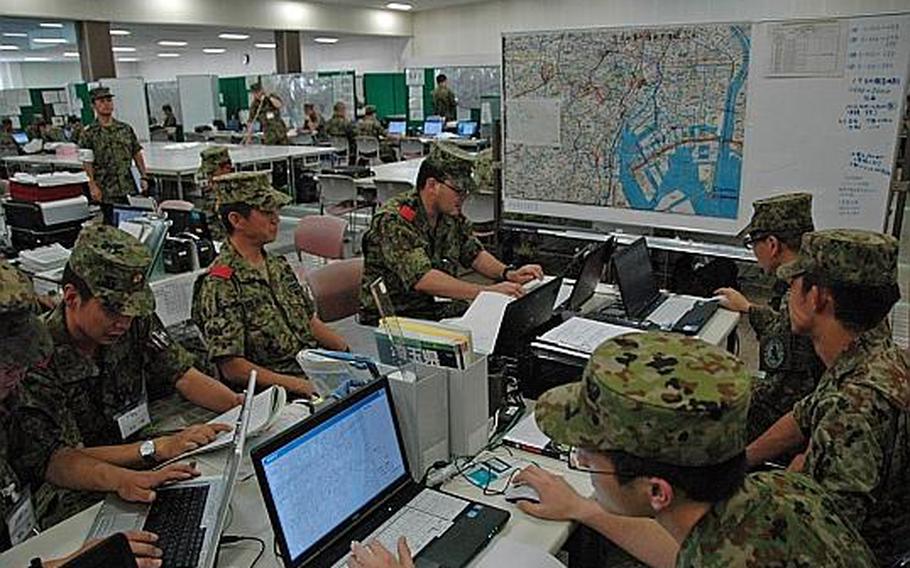
Japanese troops plan relief convoys during an exercise July 19, 2012, designed to test the ability of U.S. and Japanese forces to repond to a massive earthquake in Tokyo. (Seth Robson/Stars and Stripes)
YOKOTA AIR BASE, Japan — U.S. military personnel have participated for the first time in an annual Japanese exercise designed to prepare for a major earthquake in Tokyo.
The Japanese capital, home to some of America’s largest overseas bases, has a 70 percent chance of experiencing a severe quake in the next four years, experts say. Last year’s 9.0 magnitude shock to the north caused a massive tsunami that killed more than 20,000 people. The Fukushima Dai-ichi nuclear power plant also was damaged.
Last week, U.S. soldiers, sailors, airmen and Marines joined 5,000 Japanese soldiers, police, firefighters and local government officials in a weeklong exercise designed to test their ability to get rescuers, food and water to survivors of an 8.2-magnitude earthquake centered in Tokyo Bay.
Fifteen U.S. personnel were at Camp Asaka, a Japanese base in Tokyo, to coordinate American forces’ responses to requests for help from the Japanese. During last year’s disaster, 24,000 U.S. servicemembers helped local forces deliver aid and clear debris in tsunami-damaged cities such as Sendai and Ishinomaki.
Last week’s exercise scenario included a 3-meter-high tsunami north of Tokyo and damage to a nuclear power plant that forced authorities to set up decontamination areas for fleeing civilians.
U.S. Army Capt. William Wilson, 26, of Denver — an environmental scientist who collected samples of soil, air and water to test for toxins during Operation Tomodachi, last year’s disaster response effort — said personnel involved in the latest exercise were well aware that they were training for a real-world mission.
A large earthquake in Tokyo “is probably going to happen,” he said.
Capt. Jeffrey Anderson, 35, of Salt Lake City, an Army intelligence officer, gathered information for U.S. commanders during the exercise.
The scenario called for Marines to be dispatched from Okinawa, while the Army, Navy and Air Force mobilized their trucks, ships and planes to haul personnel and supplies. The U.S. Embassy and U.S. Agency for International Development were providing U.S. troops with mission parameters, Anderson said.
Japanese personnel working alongside the Americans during the exercise sat in rooms full of maps and computers at Camp Asaka organizing supply depots and convoys through the disaster zone.
Minoro Kanada, an official with Kanagawa prefecture’s Disaster Prevention Department, said he worked with Americans during Operation Tomodachi and that their help would be important in any future disaster.
Col. Kauyoshi Suchiro, commander of some of the Japanese troops at Camp Asaka, was also happy to work alongside the U.S. troops.
“Your country is very important for Japan,” he said.